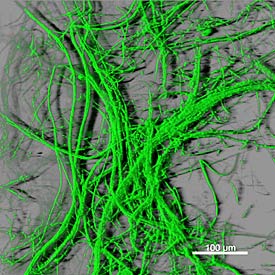Press release from March 24, 2011
Untapped potential
Fungi set to be deployed against hazardous chemicals far more often
Leipzig. Ecosystem services of the type provided by fungi could in future be used far more frequently in environmental technology than before. Their huge potential has so far barely been tapped, according to scientists from the Helmholtz Centre for Environmental Research (UFZ) writing in the March edition of journal Nature Reviews Microbiology. However, in order to harness fungi’s amazing abilities for environmental protection, they should not be treated like inanimate catalysts; instead, their ecology needs to be respected. Although fungi make up the majority of living biomass in the soil and are also prevalent in bodies of water, hitherto they have hardly been used for biological cleanup.

Image of the soil fungi Fusarium oxysporum taken by a Laser Scanning Microscope (Images with a higher resolution can be obtained by the Department of Public Relations)
Source: Dr. Thomas Neu/UFZ
This is surprising, for bioremediation technologies have many advantages over energy-intensive, intricate physical and chemical methods. Although cleanup takes longer, it is much cheaper and also more sustainable. With mainly bacteria being used previously, there is hence a trend towards passive cleanup methods in contaminated soils known as monitored natural attenuation. Even if they take longer than ex-situ techniques, these methods are still more energy-efficient and in the end result in ecologically intact and hence functioning ecosystems in the soil. In their review, the Leipzig-based researchers showed that apart from bacteria, fungi also have an important part to play in cleanup technologies. "Apart from their low costs, one important argument for using fungi in passive methods in future is the growing acceptance of risk-based remediation standards. These standards are already part of legislation in the USA and the UK," explains Prof Hauke Harms from UFZ. "There are therefore important financial, ecological and legal reasons for obtaining a better understanding of how fungi live so that they can be used in environmental technologies."
In the researchers’ view, fungi could be a central element of new biotechnologies helping to clean polluted soil, water or air. Previously, however, success has been limited because too little attention was paid to the ecology of fungi and often they were simply used as bacteria substitutes without exploiting their genuine strengths such as their extensive degradation capacities and their natural adaptation to certain habitats. Most fungi which can degrade pollutants are either ascomycetes or basidiomycetes. At present, only little is known about fungi from other phyla in this respect.
Fungi are a separate kingdom in nature alongside animals and plants. They include not just the well-known edible mushrooms but also symbionts of for instance plants (mycorrhizae) and algae
(lichen). So far, fewer than 100,000 of the estimated 1.5 million species of fungi have been described. Since they are a sort of macroorganism packed into microscopic units, they have superbly
adapted to diverse environmental conditions. Fungi form up to 75 per cent of the microbial biomass in the soil. Unlike bacteria, they do not depend on continuous paths of water in order to spread.
In 2007, microbiologists from UFZ showed that fungal hyphae play an important part in the spread of bacteria in the soil. Although air and a lack of moisture prevent their spread, bacteria use the
fungal hyphae to move through the soil as if on a sort of motorway network.
Tilo Arnhold
Publication
Harms, H., D. Schlosser, L. Y. Wick (2011):
Untapped potential: exploiting fungi in bioremediation of hazardous chemicals. Nature Reviews Microbiology 9: 177-192. doi:10.1038/nrmicro2519
www.nature.com/nrmicro/journal/v9/n3/full/nrmicro2519.html
More information
Prof. Hauke Harms, Dr. Dietmar Schlosser, Dr. Lukas Y. Wick
Helmholtz Centre for Environmental Research (UFZ)
Telephone: +49 341 235 1260, -1329, -1316
Prof. Hauke Harms
Dr. Dietmar Schlosser
Dr. Lukas Y. Wick
or
Tilo Arnhold
Helmholtz Centre for Environmental Research (UFZ)
Public Relations
presse@ufz.de
+49 341 235 1635
Links
Background - microbiological diversity: UFZ Research group: Environmental Mycology UFZ research group: Bioavailability By fungus through the soil (press release in German dated 8 February 2007):
{%%%REPLACE_LINK_2%%%}
www.ufz.de/index.php?de=16781
www.ufz.de/index.php?de=16774
www.ufz.de/index.php?de=10837
